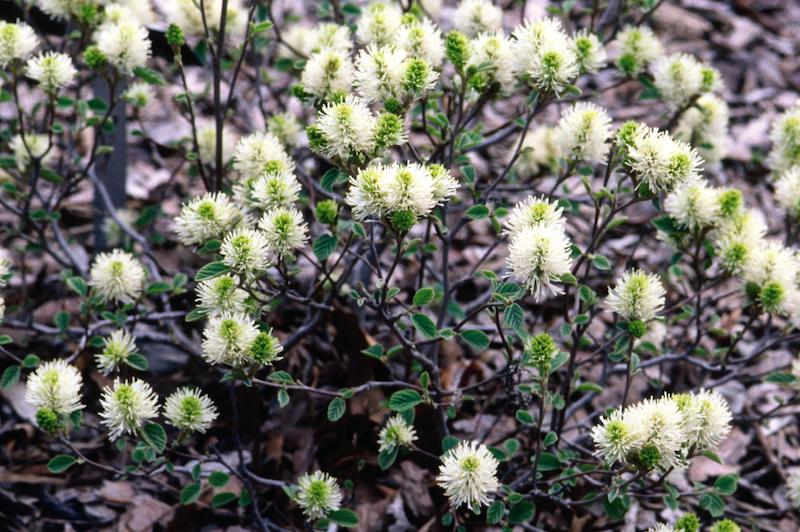Fothergillas are popular shrubs to grow due to their wonderful spring flowers and spectacular autumn foliage. Native to the Southeastern United States, these shrubs are low-maintenance and highly pest resistant. The most common pests of this plant are deer, rabbits, and gall aphids. Damage from these pests is usually minor, and fothergilla recovers nicely with care and control. Focus on monitoring and excluding these pests from your garden to grow healthy, happy fothergilla shrubs.

Common Fothergilla Pests
Deer
Deer are occasional pests of fothergilla. While they prefer to browse other plants for food, fothergilla may be a target when little else is available to eat. Most deer damage to fothergilla occurs in the spring, as deer are attracted to the sweet-scented flowers of this plant. Young, newly planted shrubs may also be more susceptible.
Deer damage appears as uneven tearing of leaves, stems, and branches. If deer feed on fothergilla early or late in the growing season, they may remove the current year’s and next year’s flower buds, respectively.
Treating Deer Damage on Fothergilla
Fothergilla will recover from deer damage with proper care. Prune out any damaged branches or leaves immediately after fothergilla finishes blooming since this shrub blooms on old wood. If the damage is severe enough, prune away at any time. Fothergilla will fail to bloom in future seasons if deer consume the flower buds.
Encourage new growth by fertilizing plants once per spring with a slow-release fertilizer formulated for acidic-loving plants. Alternatively, a liquid fertilizer can be applied monthly from spring through mid-summer.
Preventing Deer Damage on Fothergilla
Fothergilla will need to be protected in spring when plants are blooming. Many organic deer repellents are commercially available. Apply a liquid deer repellent around and on the plant throughout April and May. Since water dilutes the product and reduces its efficacy, liquid repellents will need to be reapplied following precipitation. Only apply repellents during dry conditions. Keep in mind that deer may get used to the scent of many repellents with time and overuse. Therefore, only apply repellents in spring when fothergilla is most likely to be bothered by deer.
Rabbits
As with deer, fothergilla is not a preferred food for rabbits unless very little is available to eat. Rabbit damage on fothergilla looks like neatly angled clippings of smaller, newer stems and chewing of thicker, woody branches. This can be differentiated from the uneven tearing of fothergilla branches, stems, and leaves from deer. Rabbits are more likely to target low-growing branches and small, young plants. Most rabbit damage to fothergilla occurs over winter when food sources are scarce. In severe cases, rabbits may chew entire plants down to the ground level.
Treating Rabbit Damage on Fothergilla
In most instances, fothergilla will recover from rabbit damage. If your fothergilla is chewed down to the ground, it may take several growing seasons for significant growth to appear and return to normal. Prune back any branches and stems damaged by rabbits. Keep newly planted fothergilla watered each week to establish healthy roots. Once fothergilla becomes established, it will become more resilient to rabbit damage. Use a liquid or slow-release granular fertilizer per label instructions to stimulate new growth.
Preventing Rabbit Damage on Fothergilla
Provide year-round protection to newly planted fothergilla, especially in winter. Cover small plants with plastic netting to protect them from hungry rabbits. Fothergilla can also be fenced off to prevent rabbits from eating them. Make sure the fence is at least 2-3 feet high with no large gaps for rabbits to squeeze through. Many of the liquid repellents used for deer are also effective for rabbits. Like deer, rabbits may also become accustomed to the scent of repellents. Use this option only if installing physical barriers is not possible.
Gall Aphids
Gall aphids are sap-sucking, soft-bodied insects in the genus Hamamelistes. While relatively uncommon pests of fothergilla, gall aphids have been more frequently found on fothergilla’s relative, witch hazel (Hamamelis spp). Cone-shaped galls containing aphids form on leaves or in place of the seed heads. These gall aphids require alternative hosts to complete their life cycle, moving from birch trees (Betula spp.) to witch hazel or fothergilla. Gall aphids are not fatal for fothergilla, but they can cause unsightly damage.
Treating Gall Aphids on Fothergilla
Since gall aphids are mostly an aesthetic concern, treatment is not necessary for the health of the plant. Once gall aphids have been spotted on fothergilla, there is no way to stop the damage from occurring as the galls expand. Prune out any branches that have galls. A dormant oil applied in winter may kill any aphid eggs remaining on the plant.
Preventing Gall Aphids on Fothergilla
After pruning the galls from the affected branches, destroy the galls immediately to prevent future infestations. Select a pesticide labeled for control of gall aphids and apply it at bud break to prevent infestations the following year.
These insects have a complicated life cycle with several alternations of hosts between birches and plants in the witch hazel family. Consider treating or removing any nearby birch or witch hazel plants to eliminate potential hosts for this pest. Provide plenty of habitat for beneficial insects that may prey on gall aphids, such as parasitoid wasps. Grow species of plants of varying height, form, and bloom time.
Fothergilla Pests Chart
|
Pest |
Identifying |
Treating |
|
Deer |
Uneven tearing of leaves, stems, and branches |
Prune damaged branches after blooming |
|
Rabbits |
Neatly angled clippings of smaller, newer stems and chewing of thicker, woody branches |
Prune back any branches and stems |
|
Gall Aphids |
Cone-shaped galls form on leaves or in place of the seed heads |
Prune out any branches that have galls |
Sources: "Fothergilla." Clemson University, Clemson Cooperative Extension. hgic.clemson.edu
 |
Lauren Youngcourt - Published 06-17-2023 |

